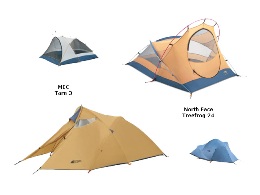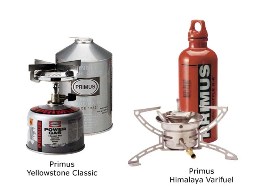| Gear 101 |
Tents
Tents are often categorized into 3-season or 4-season. The main difference is that
the 4 season uses heavier material and more poles as it needs to sustain stronger
winds and heavier rain/snow. My advice is to get a 3-season tent to start with, as
you can still go winter camping with it. You will just need to supplement it with a
better sleeping bag and a tarp.
However if you get a 4-season tent and try using it in summer time, I guarantee you
will regret bringing the tent along. It is just too hot and stuffy to stay inside,
and you can't keep the door open because of the bugs.
Features you should pay attention to are the "Packed weight" and "Ease of setup". A
lot of manufacturers advertise a lower weight to boost their sales. However, the average
packed weight is about 15% more than its advertised weight.
Ask yourself, "Can I easily set this tent up by myself in the rain?". Some tents are really
difficult to setup, but may provide extra strength and comfort. You need to decide which
aspect is more important to you.
|
| |

|
|
|
My pick on Tents.
|
|
My advices for choosing a tent include:
a) A 2-person 3-season tent should weigh no more than 4 1/2 lbs.
b) Select a model with a rain-fly that covers all the way to the ground.
You can always roll up the fly if it is too long, but when the rain comes, it shows no mercy.
c) Don't buy 4-person tents simply because it is just too bulky to fit inside a pack.
Why not get two 2-person tents and share the weight? Yes, think about the
snoring at night too.
A few of my favourite tents:
- North Face TreeFrog 24
- MEC Tarn 3 and MSR Hubba Tent.
|
|
|
| |
| |

|
|
|
My picks on stoves
|
|
Stoves
Stoves have shown a lot of technical improvements since the 1990s. I still remember
when I used a 4-lb kerosene stove when I was a scout. The key to choosing a stove is
the fuel type and weight.
There are a variety of fuel types. Depending on where you travel, how high the elevation
is and how cold it will be, different fuel types offer different benefits. Generally,
propane/butane are the best for most terrains. However, propane/butane won't vaporize and
burn efficiently at high elevations. White gas will work at higher elevation, but it requires
longer priming time.
Kerosene may be the cheapest fuel, but in my opinion it is the worst choice. It smells
terrible and leaves a residue in the stove after burning. I have found the stove will
require a lot of maintenance. You should also consider fuel type if you plan to travel
overseas with a stove, as not all countries supply all fuels.
Multi-fuel stoves are becoming more common and popular. I bought one in 1998 and have
been using it ever since. It will burn any petroleum based fuel. When burning kerosene,
I simply need to change the nozzle. I also own a compact propane/butane canister stove
for its ultra light weight and ease of use. Screw it on, spark and fire!
A few of my favourite stoves:
- Primus Yellowstone Class (2234),
- Primus Himalaya VariFuel
|
|